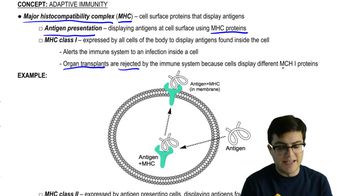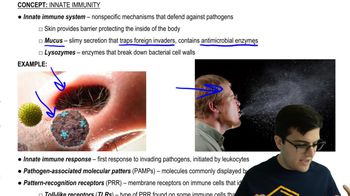What is the difference between an epitope and an antigen?
Table of contents
- 1. Introduction to Biology2h 42m
- 2. Chemistry3h 40m
- 3. Water1h 26m
- 4. Biomolecules2h 23m
- 5. Cell Components2h 26m
- 6. The Membrane2h 31m
- 7. Energy and Metabolism2h 0m
- 8. Respiration2h 40m
- 9. Photosynthesis2h 49m
- 10. Cell Signaling59m
- 11. Cell Division2h 47m
- 12. Meiosis2h 0m
- 13. Mendelian Genetics4h 44m
- Introduction to Mendel's Experiments7m
- Genotype vs. Phenotype17m
- Punnett Squares13m
- Mendel's Experiments26m
- Mendel's Laws18m
- Monohybrid Crosses19m
- Test Crosses14m
- Dihybrid Crosses20m
- Punnett Square Probability26m
- Incomplete Dominance vs. Codominance20m
- Epistasis7m
- Non-Mendelian Genetics12m
- Pedigrees6m
- Autosomal Inheritance21m
- Sex-Linked Inheritance43m
- X-Inactivation9m
- 14. DNA Synthesis2h 27m
- 15. Gene Expression3h 20m
- 16. Regulation of Expression3h 31m
- Introduction to Regulation of Gene Expression13m
- Prokaryotic Gene Regulation via Operons27m
- The Lac Operon21m
- Glucose's Impact on Lac Operon25m
- The Trp Operon20m
- Review of the Lac Operon & Trp Operon11m
- Introduction to Eukaryotic Gene Regulation9m
- Eukaryotic Chromatin Modifications16m
- Eukaryotic Transcriptional Control22m
- Eukaryotic Post-Transcriptional Regulation28m
- Eukaryotic Post-Translational Regulation13m
- 17. Viruses37m
- 18. Biotechnology2h 58m
- 19. Genomics17m
- 20. Development1h 5m
- 21. Evolution3h 1m
- 22. Evolution of Populations3h 53m
- 23. Speciation1h 37m
- 24. History of Life on Earth2h 6m
- 25. Phylogeny2h 31m
- 26. Prokaryotes4h 59m
- 27. Protists1h 12m
- 28. Plants1h 22m
- 29. Fungi36m
- 30. Overview of Animals34m
- 31. Invertebrates1h 2m
- 32. Vertebrates50m
- 33. Plant Anatomy1h 3m
- 34. Vascular Plant Transport1h 2m
- 35. Soil37m
- 36. Plant Reproduction47m
- 37. Plant Sensation and Response1h 9m
- 38. Animal Form and Function1h 19m
- 39. Digestive System1h 10m
- 40. Circulatory System1h 49m
- 41. Immune System1h 12m
- 42. Osmoregulation and Excretion50m
- 43. Endocrine System1h 4m
- 44. Animal Reproduction1h 2m
- 45. Nervous System1h 55m
- 46. Sensory Systems46m
- 47. Muscle Systems23m
- 48. Ecology3h 11m
- Introduction to Ecology20m
- Biogeography14m
- Earth's Climate Patterns50m
- Introduction to Terrestrial Biomes10m
- Terrestrial Biomes: Near Equator13m
- Terrestrial Biomes: Temperate Regions10m
- Terrestrial Biomes: Northern Regions15m
- Introduction to Aquatic Biomes27m
- Freshwater Aquatic Biomes14m
- Marine Aquatic Biomes13m
- 49. Animal Behavior28m
- 50. Population Ecology3h 41m
- Introduction to Population Ecology28m
- Population Sampling Methods23m
- Life History12m
- Population Demography17m
- Factors Limiting Population Growth14m
- Introduction to Population Growth Models22m
- Linear Population Growth6m
- Exponential Population Growth29m
- Logistic Population Growth32m
- r/K Selection10m
- The Human Population22m
- 51. Community Ecology2h 46m
- Introduction to Community Ecology2m
- Introduction to Community Interactions9m
- Community Interactions: Competition (-/-)38m
- Community Interactions: Exploitation (+/-)23m
- Community Interactions: Mutualism (+/+) & Commensalism (+/0)9m
- Community Structure35m
- Community Dynamics26m
- Geographic Impact on Communities21m
- 52. Ecosystems2h 36m
- 53. Conservation Biology24m
41. Immune System
Adaptive Immunity
Problem 4
Textbook Question
What is one of the differences between CD4+ and CD8+ T cells?
a. CD4+ cells are immature, and CD8+ cells are mature.
b. CD4+ cells are activated, and CD8+ cells are not.
c. CD4+ cells interact with class II MHC proteins, and CD8+ cells interact with class I MHC proteins.
d. CD4+ cells activate cell-mediated responses, and CD8+ cells activate humoral responses.
 Verified step by step guidance
Verified step by step guidance1
Understand the role of T cells in the immune system: T cells are a type of lymphocyte that play a central role in cell-mediated immunity. They are primarily involved in identifying and destroying infected cells.
Differentiate between CD4+ and CD8+ T cells: CD4+ T cells, also known as helper T cells, assist other cells in the immune response. CD8+ T cells, also known as cytotoxic T cells, directly attack and destroy infected cells.
Identify the interaction with MHC proteins: CD4+ T cells typically interact with antigens presented by class II Major Histocompatibility Complex (MHC) proteins, which are found on the surface of antigen-presenting cells. CD8+ T cells interact with antigens presented by class I MHC proteins, which are present on almost all nucleated cells.
Evaluate the options given in the problem: Option c states that CD4+ cells interact with class II MHC proteins, and CD8+ cells interact with class I MHC proteins. This aligns with the known functions and interactions of these T cell types.
Conclude which option correctly describes the difference: Based on the understanding of T cell interactions with MHC proteins, option c is the correct description of the difference between CD4+ and CD8+ T cells.
 Verified video answer for a similar problem:
Verified video answer for a similar problem:This video solution was recommended by our tutors as helpful for the problem above
Video duration:
1mPlay a video:
Was this helpful?
Key Concepts
Here are the essential concepts you must grasp in order to answer the question correctly.
T Cell Differentiation
T cells are a type of lymphocyte that play a central role in cell-mediated immunity. They differentiate into various subtypes, including CD4+ and CD8+ T cells, each with distinct functions. CD4+ T cells, also known as helper T cells, assist other cells in the immune response, while CD8+ T cells, or cytotoxic T cells, directly kill infected cells.
Recommended video:
Guided course

Cell Division and Differentiation
Major Histocompatibility Complex (MHC)
MHC molecules are proteins found on the surfaces of cells that present antigens to T cells. There are two classes: MHC class I, which presents antigens to CD8+ T cells, and MHC class II, which presents antigens to CD4+ T cells. This interaction is crucial for the activation and function of T cells in the immune response.
Recommended video:
Guided course

Major Histocompatibility Complex
Immune Response Activation
CD4+ and CD8+ T cells are involved in different types of immune responses. CD4+ T cells primarily activate and regulate other immune cells, including B cells and macrophages, facilitating the humoral and cell-mediated immune responses. CD8+ T cells are responsible for the direct killing of infected or cancerous cells, playing a key role in cell-mediated immunity.
Recommended video:
Guided course

Innate Immune Response

 5:50m
5:50mWatch next
Master Adaptive Immune Response with a bite sized video explanation from Jason
Start learningRelated Videos
Related Practice
Textbook Question
1262
views
